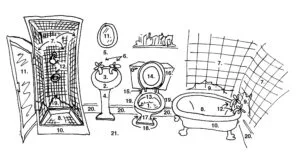Most cleans do not require a time cap as the completion of work is the priority and no one likes to cut the clean short. When the time needed is greater than your budget, you can opt to set a “Time Cap” for the clean.
Using a time cap for the wrong reason will lead to disappointment. The time cap does not mean more work gets done in less time. If you expect some work will not be completed in the time, then you want a time cap. Work is prioritized for the set time, so that the focus of the clean is on the areas you want done. Staff stop cleaning and put away tools before the set time.
A Priority List
To accommodate the limited time, you need a “Priority List” that makes sense. Priorities are listed in order of approach with the understanding that items listed last may not be completed.
Make your priority list slightly longer than time allows. Expect your last items to not get done. If you expect the last item done on your list, ask yourself if you really want a time cap. Avoid an overwhelming unrealistic long list that may cause staff to rush through high priority work in order to cover more items on the list.
Time Tip
To maximize a clean with a time cap, have the tools and products out and ready to go for staff. Set up and set down time adds up to 10 minutes at either end of clean. If you still want tools away after, we can add that directive to jobnote with the relevant locations.
Priority List < simple
The simple list is good for a home where lifestyle can vary from minimalist to chaotic one week to the next. More may be covered on good weeks and less on another.
Work from main floor and then up.
Basement done last.
Priority List < based on areas
At the beginning, you can list areas with tasks combined but towards the end of list, break down the tasks within an area in case one task cannot be covered. For example:
- Main floor dust & vacuum & mop
- Kitchen clean & mop
- 2nd floor bathroom clean & mop
- main floor bathroom clean & mop
- 2nd floor common areas (hallways & stairs)
dust
vacuum - 3rd floor common areas
dust
vacuum - vacuum common areas on 3rd floor (no mopping or dusting)
- mop of 2nd floor
- garbage
The last item – garbage – is not expected to be covered, and the mopping of 2nd floor will be a stretch but a welcome addition if staff get to it.
For this client, vacuuming the 3rd floor is a bigger priority than mopping the 2nd floor and there is no dusting or mopping of 3rd floor.
Mopping of kitchen and bathroom floors is generally assumed – but mentioned in order to assure clear messaging.
Priority List < based on tasks
- kitchen clean & mop
- clean all bathrooms & mop
- vacuum all floors staring main floor and going up
- Main floor mopped
- 2nd floor mopped
- vacuum basement
The last item – vacuum basement – is not expected to be covered and the mopping of 2nd floor will be a stretch but a welcome addition if staff get to it.
This client has deliberately not listed dusting as they like to do it themselves. However, dusting is a common item to forget. Be careful that you don’t assume a task and therefore miss it on the list.
Mopping of kitchen and bathroom floors is generally assumed – but mentioned in order to assure clear messaging.
Priority List < with rotational areas
- clean all main floor including kitchen & mop throughout
- dust & vacuum throughout 2nd floor
- 2nd floor bathrooms & mop
- rotate every 2nd clean
i. basement bathroom & mop
ii. basement living area - mop 2nd floor wood
- rotate every 2nd clean
i. garbage
ii. recycling
“Clean all” means dust, vacuum, mop and do bathrooms/kitchens on that level. However, we still add “including kitchen” and “mop throughout” here in case there is any confusion.
The last item – rotate garbage & recycling – is not expected to be covered and the mopping of 2nd floor will be a stretch but a welcome addition if staff get to it.
